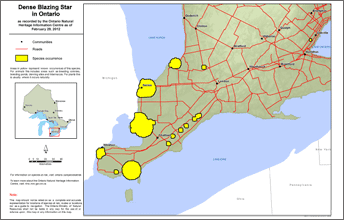Dense blazing star
Scientific name: Liatris spicata

Cover photo credit: Allen Woodliffe
Status
Threatened
“Threatened” means the species lives in the wild in Ontario, is not endangered, but is likely to become endangered if steps are not taken to address factors threatening it.
Date added to the Species at Risk in Ontario List
The Dense blazing star was already assessed as threatened when the Endangered Species Act took effect in 2008.
Read the Assessment Report
What it looks like
Dense Blazing Star is a beautiful perennial wildflower with stunning purple flowers. It can grow as tall as two metres. The stem is usually smooth with leaves arranged around it in a spiral. The flower heads have six to 10 disk flowers and are arranged in a long dense spike at the top of the plant.
The seedpods are brown or black, small and somewhat tube-shaped. In the wild, thick patches of Dense Blazing Star give the landscape a rose-purple glow.
Where it lives
In Ontario, Dense Blazing Star grows in moist prairies, grassland savannahs, wet areas between sand dunes, and abandoned fields.
This plant does not do well in the shade and is usually found in areas that are kept open and sunny by fire, floods, drought, or grazing.
Where it’s been found in Ontario
Dense Blazing Star is found only in North America. In Canada, it occurs naturally only in southwest Ontario, mainly in the area between Lake St. Clair, Lake Huron and Lake Erie. There are believed to be 11 to 13 populations in the province with six populations known to have been lost.
View a larger version of this map (PDF)
What threatens it
The main threat to Dense Blazing Star is habitat loss due to urban development or habitat alteration. Another threat is natural succession, a process where trees and shrubs take over an area and eventually shade-out the sun-loving plants.
The invasive plants, European Common Reed and Purple Loosestrife, are also a concern at some sites.
Action we are taking
Threatened Species and their general habitat are automatically protected
Recovery strategy
A recovery strategy advises the ministry on ways to ensure healthy numbers of the species return to Ontario.
Read the Executive Summary and Full Document (January 28, 2016)
Government response statement
A government response statement outlines the actions the government intends to take or support to help recover the species.
Read the government response statement (October 28, 2016)
Review of progress
A review of progress made toward protecting and recovering a species is required no later than the time specified in the species’ government response statement, or not later than five years after the government response statement is published if no time is specified.
Read the report on progress towards the protection and recovery of 18 species at risk, including Dense Blazing Star (2021).
Habitat protection
General Habitat Protection - June 30, 2013
What you can do
Report a sighting
- Report a sighting of an endangered animal or plant to the Natural Heritage Information Centre. Photographs with specific locations or mapping coordinates are always helpful.
Volunteer
- Volunteer with your local nature club or provincial park to participate in surveys or stewardship work focused on species at risk.
Be a good steward
- Private land owners have a very important role to play in species recovery. If you find Dense blazing star on your land, you may be eligible for stewardship programs that support the protection and recovery of species at risk and their habitats.
- Invasive species seriously threaten many of Ontario’s species at risk. To learn what you can do to help reduce the threat of invasive species, visit:
www.ontario.ca/invasivespecies
www.invadingspecies.com
www.ontarioinvasiveplants.ca - Pollinators, such as bees, are in steep decline across the globe and they play a key role in the survival of many of Ontario’s rare plants. For information on how you can help scientists monitor pollinator populations in Ontario visit:
www.seeds.ca/proj/poll. - Dense Blazing Star and many other species at risk depend on healthy grassland prairies, a very rare habitat in Ontario. Learn more about these habitats, the species that depend on them, and what you can do to help at:
www.tallgrassontario.org.
Report illegal activity
- Report any illegal activity related to plants and wildlife to
1-877-TIP-SMNR (847-7667) .
Quick facts
- Dense Blazing Star is able to grow in soil that is contaminated with cadmium by turning this toxic heavy metal into a non-toxic form in its tissues.
- Bees, butterflies and beetles are the main pollinators of Dense Blazing Star. You can help Ontario’s pollinators by planting insect-friendly plants such as milkweed, asters and goldenrod in your garden.
- Wild fire has traditionally played an important role in maintaining the prairie habitat of Dense Blazing Star. Fire stimulates the growth of hardy prairie flowers while naturally removing trees and shrubs that would otherwise shade-out the sun-loving plants.
- Aboriginal people have used Dense Blazing Star to treat colic, muscle pain, digestive issues and heart problems.
